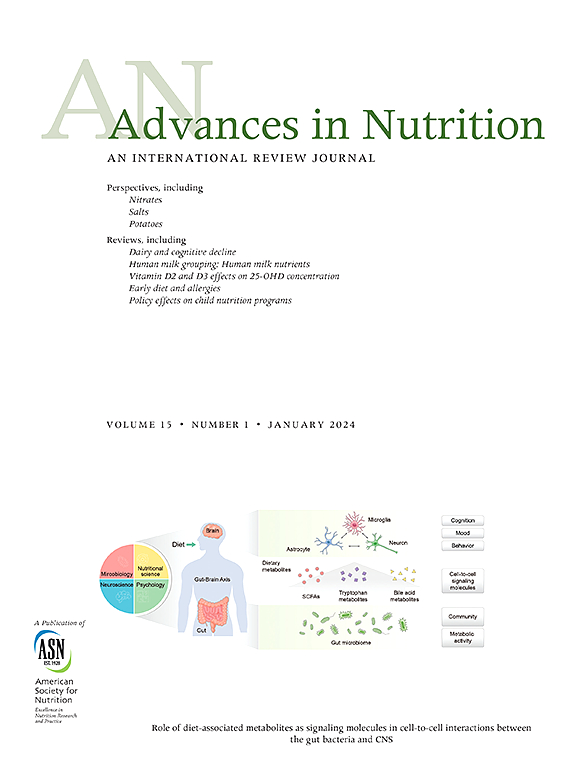食品即药物干预措施的进展及其对未来食品生产、加工和供应链的影响。
IF 9.2
1区 医学
Q1 NUTRITION & DIETETICS
引用次数: 0
摘要
食品即药物(FAM)在医生、健康保险公司、初创企业、政府公共卫生和非政府组织中是一种新兴趋势。FAM意味着将食物作为个人健康计划的一部分,以预防或帮助治疗急性和慢性健康状况和疾病。我们强调FAM干预金字塔的趋势和障碍。我们的观点是指出干预措施可能如何改变未来对特定食品类别的需求,它们在供应链中的运输以及用于加工它们的技术。根据国家指南,饮食干预可以帮助预防和治疗许多疾病,包括心血管疾病、癌症、2型糖尿病和肥胖。FAM研发和服务提供更个性化的治疗。考虑到人体对食物和相关因素(如饮食习惯、遗传、生活方式和生物圈)反应的个体间差异和复杂性,这是一项具有挑战性的工作。与采用一般健康饮食相比,量化健康改善对于证明更个性化FAM干预措施的附加价值至关重要。目前尚不清楚哪种个性化干预措施能以最低的成本为患者、医疗保健系统和气候带来最大的健康效益。FAM干预措施可以支持和补充传统医学治疗。它们将要求我们转向生产更多促进健康的食品,包括天然食品、最低限度加工食品和精选加工食品。食品加工业和供应链必须适应这些新的情况。辅助技术和方法是推动者,包括配送服务、可穿戴技术、健康监测应用程序和数据驱动的消费者行为分析。本文章由计算机程序翻译,如有差异,请以英文原文为准。
Advances in Food-As-Medicine Interventions and Their Impact on Future Food Production, Processing, and Supply Chains
Food-as-medicine (FAM) is an emerging trend among medical doctors, health insurers, startups, and governmental public-health and nongovernmental organizations. FAM implies using food as a part of an individual’s health plan to prevent or help treat acute and chronic health conditions and diseases. We highlight trends and hurdles in the FAM intervention pyramid. Our viewpoint is to indicate how interventions might change the future demand for specific food groups, their transport in supply chains, and the technologies used to process them. On the basis of national guidelines, dietary interventions can help to prevent and treat many diseases, including cardiovascular disease, cancers, type 2 diabetes, and obesity. FAM R&D and services offer more individualized treatments. This is challenging given the interindividual variability and complexity of the body’s response to food and related factors, such as dietary habits, genetics, lifestyle, and biosphere. Quantifying health improvements is essential to prove the added value of more individualized FAM interventions compared with adopting a general healthy diet. It is unclear which level of individualization of interventions produces the largest health benefits at the lowest costs for the patient, healthcare system, and climate. FAM interventions can support and complement conventional medical treatment. They will require a shift to producing more health-promoting foods, including whole foods, minimally processed foods, and selected processed foods. The food processing industry and supply chains must adapt to these new scenarios. Auxiliary technologies and methods are enablers, including delivery services, wearable technology, health-monitoring apps, and data-driven consumer behavior analysis.
求助全文
通过发布文献求助,成功后即可免费获取论文全文。
去求助
来源期刊

Advances in Nutrition
医学-营养学
CiteScore
17.40
自引率
2.20%
发文量
117
审稿时长
56 days
期刊介绍:
Advances in Nutrition (AN/Adv Nutr) publishes focused reviews on pivotal findings and recent research across all domains relevant to nutritional scientists and biomedical researchers. This encompasses nutrition-related research spanning biochemical, molecular, and genetic studies using experimental animal models, domestic animals, and human subjects. The journal also emphasizes clinical nutrition, epidemiology and public health, and nutrition education. Review articles concentrate on recent progress rather than broad historical developments.
In addition to review articles, AN includes Perspectives, Letters to the Editor, and supplements. Supplement proposals require pre-approval by the editor before submission. The journal features reports and position papers from the American Society for Nutrition, summaries of major government and foundation reports, and Nutrient Information briefs providing crucial details about dietary requirements, food sources, deficiencies, and other essential nutrient information. All submissions with scientific content undergo peer review by the Editors or their designees prior to acceptance for publication.
 求助内容:
求助内容: 应助结果提醒方式:
应助结果提醒方式:


